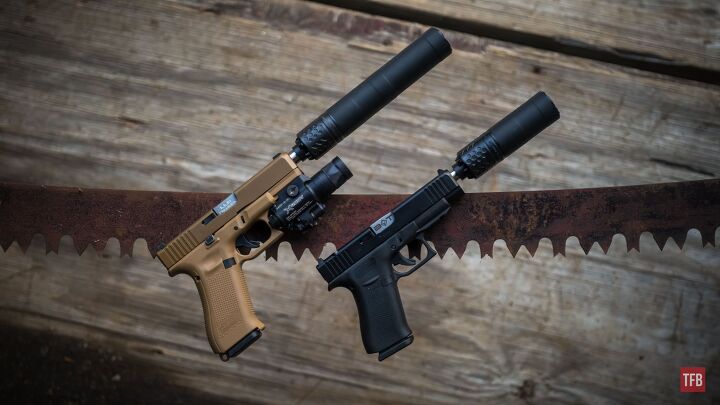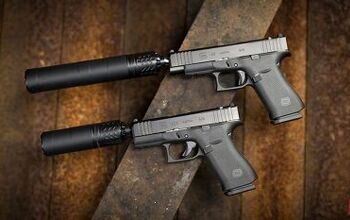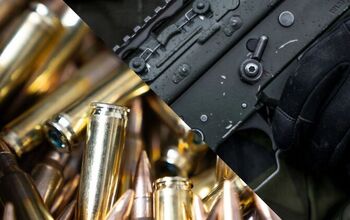SILENCER SATURDAY #167: Upcoming Reviews And Pew Science SSS

Good afternoon everyone and welcome back to another Silencer Saturday brought to you by Yankee Hill Machine, manufacturers of the mighty yet inexpensive Turbo K. Last week we answered the top 20 questions commonly asked by new and potential suppressor owners. This week we take a look at the Pew Science SSS – the Silencer Sound Standard and also get a preview of some upcoming Silencer Saturday reviews.
Upcoming Silencer Saturday Reviews:
Spring is in the air. Actually, it’s still an Arctic wasteland up here. But, Spring will eventually come and it will bring a crop of new suppressor reviews. As always, if there is something you want to see covered, please drop me a line. Here’s what we have coming up in the next few weeks:
- CGS – HYDRA-AL – (hot off today’s delivery truck from Silencer Shop)
- CGS – HYDRA-SS – (hot off today’s delivery truck from Silencer Shop)
- CGS – MOD 9 SK – (hot off today’s delivery truck from Silencer Shop)
- CGS – MOD 9 FS – (hot off today’s delivery truck from Silencer Shop)
- CGS – HELIOS QD – (hot off today’s delivery truck from Silencer Shop)
- OSS – RAD 9 – (in transit from Silencer Shop)
- OSS RAD 45 – (in transit from Silencer Shop)
- B&T – STATION SIX (patiently waiting Form 3 transfer)
- Knight’s Armament – MK23 (pending Form 3 transfer) Thanks to user ‘tallybeard’ and my friends at HKPro.com for helping me source one.
- Elevated Silence – Various models (initial conversation)
- Cadiz Gun Works – Econo Can (have yet to hit the purchase button)
SILENCER SATURDAY #167: Pew Science SSS
For years the industry has struggled to accurately relay suppressor performance to potential customers. Historically, military contracts focused a “hearing safe” 140 dB requirement and overall signature reduction to evade enemy detection. As commercial ownership has grown, our requirements have changed the way suppressors are made and tested – basic MILSTD metering at the muzzle is now only a small piece of the overall picture.
Fortunately, there are some innovators out there willing to go the extra mile in the name of silence science. Jay at PEW Science has developed a comprehensive methodology for rating suppressor performance using technology and his deep knowledge base.
Results are available to everyone as free version reports and a more detailed membership version that costs a few dollars a month. The write-ups are a silencer nerds dream, with graphs, plots, and lots of decibel ratings. Consider supporting Pew Science as a way to bring better silencer data to the industry.
Snippets from one of the free version reports can be found below.
PEW Science: Silencer Sound Standard
PEW Science: SSS.6.37 – CGS Hyperion and the Surgeon Scalpel Short Action 6.5 Creedmoor (Free Version)The PEW Science Suppression Rating™ is the new industry standard for silencer sound performance. Use it to determine how “hearing safe” a particular silencer, weapon, and ammunition is for your particular use case.
Summary: When paired with the Surgeon Scalpel 22-inch 6.5 Creedmoor rifle in an AI AXAICS chassis and fired with Prime Ammo 130gr ammunition, the CGS Hyperion in the direct thread configuration achieved a Suppression Rating™ of 58.2 in PEW Science testing.
The CGS Hyperion is a full-size 30 caliber rifle silencer that possesses extreme sound signature suppression performance with high back pressure. The silencer has no perceptible first round pop and is significantly quieter than any rifle silencer shown in PEW Science Sound Signature Reviews in the supersonic flow regime, to date. The silencer, as tested, has a weight of 15 ounces, making it one of the lighter full-size .30 silencer systems on the market. Suppression performance of the Hyperion with 6.5 Creedmoor, like with supersonic .308, is extremely high.
Have a great week and we’ll see you here next weekend for another Silencer Saturday.
Silencer Saturday is Sponsored by Yankee Hill Machine





























![[NRAAM 2024] World's Lightest Semi-Auto 22LR? MBGL GOAT-15](https://cdn-fastly.thefirearmblog.com/media/2024/06/04/0643120/nraam-2024-world-s-lightest-semi-auto-22lr-mbgl-goat-15.jpg?size=350x220)
Comments
Join the conversation
Out of curiosity how much better does a 6.5 suppress compared to a .308? I am sure I'll figure out sooner or later. I have an Omega 300 in NFA jail (I am hoping it breaks loose next month, would make it 6 months from arriving at my FFL). Hosts are going to be a 23" Sako .308 (though I need to get it threaded by a smith), 18" AR-10 .308, 24" and 18" 6.5 Grendel ARs and a 20" Howa 6.5 Grendel. I am thinking the Howa is going to be the quietest by a lot.
A few quick checks on 6.5CM vs .308 seems like 6.5CM is typically 2-4dB quieter suppressed than .308. I'd think 6.5G would be at least another couple dB quieter than 6.5CM.
I am guessing I am still going to need at least some really basic hearing protection even with a 20" 6.5 Grendel bolt gun for range shooting. Mostly was getting one to keep hearing damage to a minimum while hunting, which is usually only a shot or two (or three if I am having a REAL bad day). Which it'll sure do even if not completely hearing safe.
If I had to butcher together an explanation of Jay’s Silencer Sound Standard, it’s that we have always accepted that a decibel meter, which can only tell us the single highest peak sound impulse of a shot, is the best we can do to make objective comparisons between cans. Additionally, OSHA’s once daily 140db limit has long been our only “objective” metric for “hearing safe.”
Meanwhile, end users have always expressed how qualitative and subjective silencers can sound, their decibel meter ratings notwithstanding, using words like “pleasant,” or “tone.” That’s why YouTube recordings proliferate, but those can’t tell us anything at all about loudness. What I think the Silencer Sound Standard attempts to do, is to represent a dosimeter of sorts for sound dosage to your ear - think X-rays. The standard allows for these sound dosage metrics at both the ear and muzzle, and it encompasses the sound’s whole waveform - the total sound - rather than just that waveform’s highest peak.
It’s a measure of a can’s total loudness, ranked on a dosage scale of hearing safety.
The thing about Pew Science is, that the more data Jay publishes, the more end users and manufacturers report that they simply don’t find themselves disagreeing with its findings. It’s become only more and more legit, and was probably the single most trusted metric in the industry months ago already. There is an extremely conspicuous lack of industry pushback. At worst there are quiet “oh s***” noises (or if you’re CGS, rooster noises). I’ve already made purchases based on this data alone, and intend to rely solely on this data moving forward. Of course, I’m also on pins and needles about purchases I made prior to Pew Science data, because it’s also a metric for buyer’s remorse...